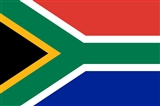
in southern Africa
. Located at the southern tip of Africa
, it is divided into nine provinces, with 2798 kilometres (1,738.6 mi) of coastline on the Atlantic
and Indian ocean
s. To the north of the country lie the neighbouring territories of Namibia
, Botswana
and Zimbabwe
; to the east are Mozambique
and Swaziland
; while Lesotho
is an enclave
surrounded by South African territory.
South Africa is multi-ethnic and has diverse cultures and languages.
1795 The first occupation by United Kingdom of Cape Colony, South Africa with the Battle of Hout Bay, after successive victories at the Battle of Muizenberg and Wynberg, after William V requested protection against revolutionary France's occupation of the Netherlands.
1815 The East Indiaman ship Arniston is wrecked during a storm at Waenhuiskrans, near Cape Agulhas, present-day South Africa, with the loss of 372 lives.
1829 South African College is founded in Cape Town, South Africa; it will later separate into the University of Cape Town and the South African College Schools.
1838 Battle of Blood River: Voortrekkers led by Andries Pretorius combat Zulu impis, led by Dambuza (Nzobo) and Ndlela kaSompisi in what is today KwaZulu-Natal, South Africa.
1899 Second Boer War begins: In South Africa, a war between the United Kingdom and the Boers of the Transvaal and Orange Free State erupts.
1900 British troops are defeated by Boers at Ladysmith, South Africa.
1900 Second Boer War: In South Africa, 20,000 British troops invade the Orange Free State.
1900 In South Africa, Boers and British troops fight in the Battle of Hart's Hill.
1900 Second Boer War: In South Africa, British military leaders receive an unconditional notice of surrender from Boer General Piet Cronje at the Battle of Paardeberg.
1902 Second Boer War: The Treaty of Vereeniging ends the war and ensures British control of South Africa.

